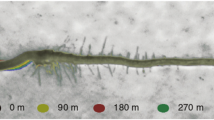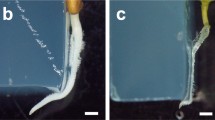Abstract
In roots, the “hidden half” of all land plants, gravity is an important signal that determines the direction of growth in the soil. Hence, positive gravitropism has been studied in detail. However, since the 19th century, the response of roots toward unilateral light has also been analyzed. Based on studies on white mustard (Sinapis alba) seedlings, botanists have concluded that all roots are negatively phototropic. This “Sinapis-dogma” was refuted in a seminal study on root phototropism published a century ago, where it was shown that less then half of the 166 plant species investigated behave like S. alba, whereas 53% displayed no phototropic response at all. Here we summarize the history of research on root phototropism, discuss this phenomenon with reference to unpublished data on garden cress (Lepidium sativum) seedlings, and describe the effects of blue light on the negative bending response in Thale cress (Arabidopsis thaliana). The ecological significance of root phototropism is discussed and the relationships between gravi- and phototropism are outlined, with respect to the starch-statolith-theory of gravity perception. Finally, we present an integrative model of gravi- and blue light perception in the root tip of Arabidopsis seedlings. This hypothesis is based on our current view of the starch-statolith-concept and light sensing via the cytoplasmic red/blue light photoreceptor phytochrome A and the plasma membrane-associated blue light receptor phototropin-1. Open questions and possible research agendas for the future are summarized.






Similar content being viewed by others
References
Al-Shehbaz IA, Beilstein MA, Kellogg EA (2006) Systematics and phylogeny of the Brassicaceae (Crucifera): an overview. Plant Syst Evol 259:98–120
Barlow P (1995) Gravity perception in plants: a multiplicity of systems derived by evolution. Plant Cell Environ 18:951–962
Barlow P (2002) The root cap: cell dynamics, cell differentiation and cap function. J Plant Growth Regul 21:261–286
Bartels D, Melis T, Scheel D, Buchen B (2011) In recognition and memoriam. Planta 233:857–858
Batschauer A (ed) (2003) Photoreceptor and light signalling. Royal Society of Chemistry, Cambridge
Blaauw AH (1918) Licht und Wachstum III. Med Landbouwhoogesch Wageningen 15:89–204
Boccalandro HE, De Simone SN, Bergmann-Honsberger A, Schepens I, Frankhauser C, Casal JJ (2008) Phytochrome kinase substrate 1 regulates root phototropism and gravitropism. Plant Physiol 146:108–115
Briggs WR (1963a) Mediation of phototropic responses of corn coleoptiles by lateral transport of auxin. Plant Physiol 38:237–247
Briggs WR (1963b) The phototropic response of higher plants. Annu Rev Plant Physiol 14:311–352
Briggs WR (2006) Blue/UV-A receptors: historical overview. In: Schäfer E, Nagy F (eds) Photomorphogenesis in plants and bacteria: function and signal transduction mechanisms, 3rd edn. Springer, Dordrecht, pp 171–197
Briggs WR (2007) The LOV domain: a chromophore module servicing multiple photoreceptors. J Biomed Sci 14:499–507
Briggs WR (2010) A wandering pathway in plant biology: from wildflowers to phototropins to bacterial virulence. Annu Rev Plant Biol 61:1–20
Briggs WR, Christie JM (2002) Phototropins 1 and 2: versatile plant blue-light receptors. Trends Plant Sci 7:204–210
Briggs WR, Spudich J (eds) (2005) Handbook of photosensory receptors. Wiley-VCH, Weinheim
Briggs WR, Tocher RD, Wilson JF (1957) Phototropic auxin redistribution in corn coleoptiles. Science 126:210–212
Briggs WR, Beck CF, Cashmore AR, Christie JM, Hughes J, Jarillo JA, Kagawa T, Kanegae H, Liscum E, Nagatani A, Okaida K, Salomon M, Rudiger W, Sakai T, Takano M, Wada M, Watson J (2001) The phototropin family of photoreceptors. Plant Cell 13:993–997
Butler WL, Norris KH, Siegelmann HW, Hendricks SB (1959) Detection, assay, and preliminary purification of the pigment controlling photoresponsive development of plants. Proc Natl Acad Sci USA 45:1703–1708
Chen R, Rosen E, Masson PH (1999) Gravitropism in higher plants. Plant Physiol 120:343–350
Christie JM, Reymond P, Powell G, Bernasconi P, Reibekas AA, Liscum E, Briggs WR (1998) Arabidopsis NPH1: A flavoprotein with the properties of a photoreceptor for phototropism. Science 282:1698–1701
Correll MJ, Kiss JZ (2005) The roles of phytochromes in elongation and gravitropism of roots. Plant Cell Environ 46:317–323
Darwin C (1880) The power of movement in plants. John Murray, London
Darwin F (1882) Über das Wachstum negativ heliotropischer Wurzeln im Licht und im Finstern. Arbeiten Bot Inst Würzburg 2:521–528
DuHamel HL (1758) La Physique des Arbres. Chez HL Guerin & LF Delatour, Paris
Esmon C, Pedmale U, Liscum E (2005) Plant tropisms: providing the power of movements in a sessile organism. Int J Dev Biol 49:665–674
Franklin KA, Quail PH (2010) Phytochrome functions in Arabidopsis development. J Exp Bot 61:11–24
Galen C, Huddle J, Liscum E (2004) An experimental test of the adaptive evolution of phototropism: blue-light receptors controlling phototropism in Arabidopsis thaliana. Evolution 58:515–523
Galen C, Rabenold JJ, Liscum E (2006) Functional ecology of a blue light photoreceptor: effects of phototropin-1 on root growth enhance drought tolerance in Arabidopsis thaliana. New Phytol 173:91–99
Haberlandt G (1900) Über die Perception des geotropischen Reizes. Ber Deutsch Bot Ges 18:261–272
Han I-S, Tseng T-S, Eisinger W, Briggs WR (2008) Phytochrome A regulates the intracellular distribution of phototropin 1-green fluorescent protein in Arabidopsis thaliana. Plant Cell 20:2835–2847
Hart JW (1990) Plant tropisms and other growth movements. Chapman & Hall, London
Holland JJ, Roberts D, Liscum E (2009) Understanding phototropism: from Darwin to today. J Exp Bot 60:1969–1978
Hubert B, Funke GL (1937) The phototropism of terrestrial roots. Biol Jaarboek 4:286–315
Imaizumi T, Tran GH, Swartz TE, Briggs WR, Kay SA (2003) FKF1 is essential for photoperiodic-specific light signalling in Arabidopsis. Nature 426:302–306
Kiss JZ, Guisinger M, Miller A, Stackhouse K (1997) Reduced gravitropism in hypocotyls of starch-deficient mutants of Arabidopsis. Plant Cell Physiol 38:518–525
Kiss JZ, Mullen JL, Correll MJ, Hangarter RP (2003a) Phytochromes A and B mediate red-light-induced positive phototropism in roots. Plant Physiol 131:1–7
Kiss JZ, Cornell MJ, Mullen JL, Hangarter RP, Edelmann RE (2003b) Root phototropism: how light and gravity interact in shaping plant form. Gravi Space Biol Bull 16:55–60
Knieb E, Salomon M, Rüdiger W (2004) Tissue-specific and subcellular localization of phototropin determined by immunoblotting. Planta 218:843–851
Knight TA (1806) On the direction of the radicle and germen during the vegetation of seeds. Philos Trans R Soc Lond-Biol Sci 99:108–120
Koller D (2011) The restless plant. Harvard University Press, Cambridge
Kutschera U (1990) Cell-wall synthesis and elongation growth in hypocotyls of Helianthus annuus L. Planta 181:316–323
Kutschera U (2001) Gravitropism of axial organs in multicellular plants. Adv Space Res 27:851–860
Kutschera U, Briggs WR (2009) From Charles Darwin’s botanical country-house studies to modern plant biology. Plant Biol 11:785–795
Kutschera U, Hoss R (1995) Mobilization of starch after submergence of air-grown rice coleoptiles: implications for growth and gravitropism. Bot Acta 108:266–269
Kutschera U, Niklas KJ (2007) The epidermal-growth-control theory of stem elongation: an old and a new perspective. J Plant Physiol 164:1395–1409
Kutschera U, Niklas KJ (2009) Evolutionary plant physiology: Charles Darwin’s forgotten synthesis. Naturwissenschaften 96:1339–1354
Kutschera U, Siebert C, Masuda Y, Sievers A (1990) Effects of submergence on development and gravitropism in the coleoptile of Oryza sativa L. Planta 183:112–119
Kutschera U, Deng Z, Oses-Prieto JA, Burlingame AL, Wang Z-Y (2010) Cessation of coleoptile elongation and loss of auxin sensitivity in developing rye seedlings: a quantitative proteomic analysis. Plant Signal Behav 5:509–517
Laxmi A, Pan J, Morsy M, Chen R (2008) Light plays an essential role in intracellular distribution of auxin efflux carrier PIN2 in Arabidopsis thaliana. PloS One 1:e1510
Li Y, Dai X, Cheng Y, Zhao Y (2011) NPY genes play an essential role in root gravitropic responses in Arabidopsis. Mol Plant 4:171–179
Linsbauer K, Vouk V (1909) Zur Kenntnis des Heliotropismus der Wurzeln. Ber Deutsch Bot Ges 27:151–156
Liscum E, Briggs WR (1995) Mutations in the NPH1 locus of Arabidopsis disrupt the perception of phototropic stimuli. Plant Cell 7:473–485
Mandoli DF, Ford GA, Waldron LJ, Nemson JA, Briggs WR (1990) Some spectral properties of several soil types: implications for photomorphogenesis. Plant Cell Environ 13:287–294
Mohr H (1972) Lectures on photomorphogenesis. Springer-Verlag, Berlin
Naundorf G (1940) Untersuchungen über den Phototropismus der Keimwurzeln von Helianthus annuus. Planta 30:639–663
Nemeć B (1900) Über die Art der Wahrnehmung des Schwerkraftreizes bei den Pflanzen. Ber Deutsch Bot Ges 18:241–245
Niklas KJ, Kutschera U (2009) The evolutionary development of plant body plans. Funct Plant Biol 36:682–695
Niklas KJ, Kutschera U (2010) The evolution of the land plant life cycle. New Phytol 185:27–41
Pfeffer W (1904) Pflanzenphysiologie. Ein Handbuch des Stoffwechsels und Kraftwechsels in der Pflanze. Band II. 2. Auflage. Verlag Wilhelm Engelmann, Leipzig
Pratt LH, Coleman RA (1974) Phytochrome distribution in etiolated grass seedlings as assayed by an indirect antibody-labeling method. Am J Bot 61:195–202
Rizzini L, Favory J-J, Cloix C, Faggionato D, O’Hara A, Kaiserli E, Baumeister R, Schafer E, Nagy F, Jenkins GI, Ulm R (2011) Perception of UV-B by the Arabidopsis UVR8-protein. Science 332:103–106
Sachs J (1875) Geschichte der Botanik vom 16. Jahrhundert bis 1860. Druck und Verlag von R. Oldenbourg, München
Sachs J (1882) Vorlesungen über Pflanzen-Physiologie. Verlag Wilhelm Engelmann, Leipzig
Sakamoto K, Briggs WR (2002) Cellular and subcellular localization of Phototropin 1. Plant Cell 14:1723–1735
Schaefer R (1911) Heliotropismus der Wurzeln. Buchdruckerei Gutenberg, Charlottenburg
Schäfer E, Nagy F (eds) (2005) Photomorphogenesis in plants and bacteria: function and signal transduction mechanisms, 3rd edn. Springer-Verlag, Dordrecht, The Netherlands
Schneider HAW (1965) Kritische Versuche zum Problem des Phototropismus bei Wurzeln. Z Bot 52:451–499
Schopfer P, Brennicke A (2006) Pflanzenphysiologie, 6th edn. Springer-Verlag Berlin, Heidelberg
Schwarz H, Schneider HAW (1987) Immunological assay of phytochrome in small sections of roots and other organs of maize (Zea mays L.) seedlings. Planta 170:152–160
Sievers A (1984) Sinneswahrnehmung bei Pflanzen: Graviperzeption. Westdeutscher Verlag GmbH, Opladen
Sievers A, Hensel W (1982) The nature of graviperception. In: Wareing PF (ed) Plant growth substances 1982. Academic Press, London, pp 497–506
Sievers A, Kruse S, Kuo-Huang L, Wendt M (1989) Statoliths and microfilaments in plant cells. Planta 179:275–278
Smith H (2000) Phytochromes and light signal perception by plants: an emerging synthesis. Nature 407:585–591
Srivastava LM (2002) Plant growth and development: hormones and environment. Academic Press, San Diego
Stranga JP, Boonsiricha K, Sedbrook JC, Otegni MS, Masson PH (2009) A role for the TOC complex in Arabidopsis root gravitropism. Plant Physiol 149:1896–1905
Strasburger E, Jost L, Schenck H, Karsten G (1911) Lehrbuch der Botanik für Hochschulen, 11th edn. Verlag Gustav Fischer, Jena
Tong H, Leasure CD, Hou X, Yuen G, Briggs W, He Z-H (2008) Role of root UV-B sensing in Arabidopsis early seedling development. Proc Natl Acad Sci USA 106:21039–21044
Tseng T-S, Frederickson MA, Briggs WR, Bogomolini RA (2010) Light-activated bacterial LOV-domain histidine kinases. Methods Enzymol 471:126–134
Vitha S, Zhao L, Sack FD (2000) Interaction of root gravitropism and phototropism in Arabidopsis wild-type and starchless mutants. Plant Physiol 122:453–461
Whippo CW, Hangarter RP (2006) Phototropism: bending towards enlightenment. Plant Cell 18:1110–1119
Wiesner J (1884) Untersuchungen über die Wachstumsbewegungen der Wurzeln. Sitzungsber Akad Wiss Wien Math-Naturwiss Kl I 89:223–302
Acknowledgments
Part of this work was carried out at the Institute of Biology, University of Kassel, Germany. We thank the Alexander von Humboldt-Stiftung (AvH), Bonn, Germany (AvH Fellowship, Stanford/2010–2011 to UK.) and the US National Science Foundation (NSF Grants 0091384 and 0211605 to W.R.B.) for financial support.
Author information
Authors and Affiliations
Corresponding author
Additional information
This article is dedicated to the memory of the German plant biologist Andreas Sievers (1931–2009), a pioneer in the study of root gravitropism.
Rights and permissions
About this article
Cite this article
Kutschera, U., Briggs, W.R. Root phototropism: from dogma to the mechanism of blue light perception. Planta 235, 443–452 (2012). https://doi.org/10.1007/s00425-012-1597-y
Received:
Accepted:
Published:
Issue Date:
DOI: https://doi.org/10.1007/s00425-012-1597-y




